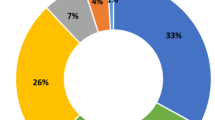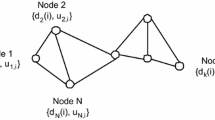Abstract
Spatial and temporal correlation between sensor observations in an Internet of Things environment can be exploited to eliminate unnecessary transmissions. Transmitting less data certainly contributes to meet the growing need for energy-saving and robust transmissions, thus prolong the lifespan of the entire WSN. Spatiotemporal correlation-based dual prediction (DP) and data compression (DC) schemes aim to reduce the amount of data transmission while ensuring data accuracy. In practice, however, the existing methods restrict the stability of the system when the model hyper-parameters are uncertain. Thus adaptive model has lately attracted extensive attention for the development of resource-constrained WSN. In this paper, we propose a gradient-based adaptive model that implements both schemes in a two-tier data reduction framework. To the best of our knowledge, the proposed scheme is the first attempt to introduce adaptiveness into both the DP and DC schemes by using a simple gradient optimization method. Gradient-based Optimal Step-size LMS (GO-LMS) is introduced to make the DP aspects adaptive, while a Gradient-based Adaptive PCA (GA-PCA) approach is used for the DC aspects. The Barzilai–Borwein method is incorporated into the gradient optimization to enable adaptive computation of the step-size for each iteration. Through extensive simulations, the developed framework was found to outperform other state-of-the-art schemes in terms of both the transmission reduction ratio and data recovery accuracy.










Similar content being viewed by others
References
Rault, T., Bouabdallah, A., & Challal, Y. (2014). Energy efficiency in wireless sensor networks: A top-down survey. Computer Networks, 67, 104–122.
Vuran, M. C., Akan, Ö. B., & Akyildiz, I. F. (2004). Spatio-temporal correlation: Theory and applications for wireless sensor networks. Computer Networks, 45(3), 245–259.
Jarwan, A., Sabbah, A., & Ibnkahla, M. (2019). Data transmission reduction schemes in WSNs for efficient IoT systems. IEEE Journal on Selected Areas in Communications, 37(6), 1307–1324.
Liazid, H., Lehsaini, M., & Liazid, A. (2019). An improved adaptive dual prediction scheme for reducing data transmission in wireless sensor networks. Wireless Networks, 25(6), 3545–3555.
Chen, S., et al. (2019). A hierarchical adaptive spatio-temporal data compression scheme for wireless sensor networks. Wireless Networks, 25(1), 429–438.
Chen, S., et al. (2016). Compressive network coding for wireless sensor networks: Spatio-temporal coding and optimization design. Computer Networks, 108, 345–356.
Tayeh, G. B., et al. (2019). A spatial-temporal correlation approach for data reduction in cluster-based sensor networks. IEEE Access, 7, 50669–50680.
Kandukuri, S. (2016). Spatio-temporal adaptive sampling techniques for energy conservation in wireless sensor networks. Diss.
Tan, L., & Mou, W. (2015). Data reduction in wireless sensor networks: A hierarchical LMS prediction approach. IEEE Sensors Journal, 16(6), 1708–1715.
Shu, T., Chen, J., Bhargava, V. K., et al. (2019). An energy-efficient dual prediction scheme using LMS filter and LSTM in wireless sensor networks for environment monitoring. IEEE Internet of Things Journal, 6(4), 6736–6747.
Zhao, Z., et al. (2017). LSTM network: A deep learning approach for short-term traffic forecast. IET Intelligent Transport Systems, 11(2), 68–75.
Yu, H., et al. (2017). Spatiotemporal recurrent convolutional networks for traffic prediction in transportation networks. Sensors, 17(7), 1501.
Wu, M., Tan, L., & Xiong, N. (2016). Data prediction, compression, and recovery in clustered wireless sensor networks for environmental monitoring applications. Information Sciences, 329, 800–818.
Tan, C., Ma, S., Dai, Y. H., et al. (2016). Barzilai-borwein step size for stochastic gradient descent. Advances in Neural Information Processing Systems., 29, 685–693.
Widrow, B. (2003). 4.1.1 The LMS algorithm. In S. S. Haykin & B. Widrow (Eds.), Least-mean-square adaptive filters (Vol. 31). New York: Wiley-Interscience.
Nagumo, J.-I., & Noda, A. (1967). A learning method for system identification. IEEE Transactions on Automatic Control, 12(3), 282–287.
Slock, D. T. M. (1993). On the convergence behavior of the LMS and the normalized LMS algorithms. IEEE Transactions on Signal Processing, 41(9), 2811–2825.
Mikhael, W., et al. (1986). Adaptive filters with individual adaptation of parameters. IEEE Transactions on Circuits and Systems, 33(7), 677–686.
Manogaran, G., et al. (2018). Machine learning based big data processing framework for cancer diagnosis using hidden Markov model and GM clustering. Wireless Personal Communications, 102(3), 2099–2116.
Wolf, S., et al. (2019). A Markov-switching model for building occupant activity estimation. Energy and Buildings, 183, 672–683.
Kabir, M. H., et al. (2016). Two-layer hidden Markov model for human activity recognition in home environments. International Journal of Distributed Sensor Networks, 12(1), 4560365.
Alon, N., Matias, Y., & Szegedy, M. (1999). The space complexity of approximating the frequency moments. Journal of Computer and System Sciences, 58(1), 137–147.
Zhou, F., Park, J., & Liu, Y. (2016). Differential feature based hierarchical PCA fault detection method for dynamic fault. Neurocomputing, 202, 27–35.
Yu, T., Wang, X., & Shami, A. (2017). Recursive principal component analysis-based data outlier detection and sensor data aggregation in IoT systems. IEEE Internet of Things Journal, 4(6), 2207–2216.
Weng, J., Zhang, Y., & Hwang, W.-S. (2003). Candid covariance-free incremental principal component analysis. IEEE Transactions on Pattern Analysis and Machine Intelligence, 25(8), 1034–1040.
Li, S., Xu, L. D., & Wang, X. (2012). Compressed sensing signal and data acquisition in wireless sensor networks and internet of things. IEEE Transactions on Industrial Informatics, 9(4), 2177–2186.
Qin, Z., et al. (2018). Sparse representation for wireless communications: A compressive sensing approach.”. IEEE Signal Processing Magazine, 35(3), 40–58.
Arici, T., et al. (2003). PINCO: A pipelined in-network compression scheme for data collection in wireless sensor networks. In Proceedings of 12th international conference on computer communications and networks (IEEE Cat. No. 03EX712). IEEE.
Akyildiz, I. F., et al. (2002). Wireless sensor networks: A survey. Computer Networks, 38(4), 393–422.
Leung, H., & Haykin, S. (1991). Error bound method and its application to the LMS algorithm. IEEE Transactions on Signal Processing, 39(2), 354–358.
Acknowledgements
This work was partly supported by the Institute for Information and communications Technology Promotion (IITP) grant funded by the Korea government (MSIT) (No. 2016-0-00133, Research on Edge computing via collective intelligence of hyper-connection IoT nodes), Korea, under the National Program for Excellence in SW supervised by the IITP (Institute for Information and communications Technology Promotion) (2015-0-00914), Basic Science Research Program through the National Research Foundation of Korea (NRF) funded by the Ministry of Education, Science and Technology (2016R1A6A3A11931385 and 2017R1A2B2009095, Research on SDN-based WSN Supporting Real-time Stream Data Processing and Multi-connectivity, 2019R1I1A1A01058780, Efficient Management of SDN-based Wireless Sensor Network Using Machine Learning Technique), the second Brain Korea 21 PLUS project.
Author information
Authors and Affiliations
Corresponding author
Additional information
Publisher's Note
Springer Nature remains neutral with regard to jurisdictional claims in published maps and institutional affiliations.
Rights and permissions
About this article
Cite this article
Li, P.H., Youn, H.Y. Gradient-based adaptive modeling for IoT data transmission reduction. Wireless Netw 26, 6175–6188 (2020). https://doi.org/10.1007/s11276-020-02426-9
Published:
Issue Date:
DOI: https://doi.org/10.1007/s11276-020-02426-9




